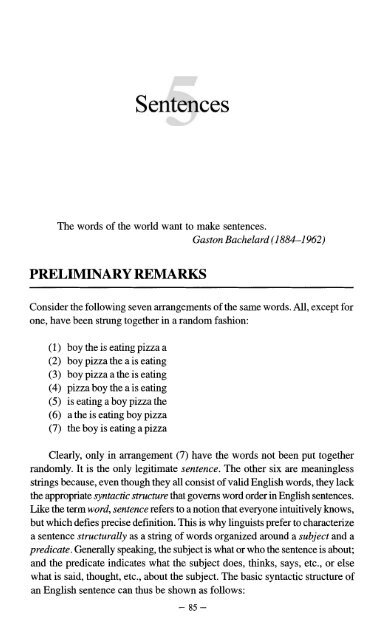A Basic Course in Anthropological Linguistics (Studies in Linguistic ...
A Basic Course in Anthropological Linguistics (Studies in Linguistic ...
A Basic Course in Anthropological Linguistics (Studies in Linguistic ...
You also want an ePaper? Increase the reach of your titles
YUMPU automatically turns print PDFs into web optimized ePapers that Google loves.
The words of the world want to make sentences.<br />
Gaston Bachelard (1 884-1 962)<br />
PRELIMINARY REMARKS<br />
Consider the follow<strong>in</strong>g seven arrangements of the same words. All, except for<br />
one, have been strung together <strong>in</strong> a random fashion:<br />
(1) boy the is eat<strong>in</strong>g pizza a<br />
(2) boy pizza the a is eat<strong>in</strong>g<br />
(3) boy pizza a the is eat<strong>in</strong>g<br />
(4) pizza boy the a is eat<strong>in</strong>g<br />
(5) is eat<strong>in</strong>g a boy pizza the<br />
(6) a the is eat<strong>in</strong>g boy pizza<br />
(7) the boy is eat<strong>in</strong>g a pizza<br />
Clearly, only <strong>in</strong> arrangement (7) have the words not been put together<br />
randomly. It is the only legitimate sentence. The other six are mean<strong>in</strong>gless<br />
str<strong>in</strong>gs because, even though they all consist of valid English words, they lack<br />
the appropriate syntactic structure that governs word order <strong>in</strong> English sentences.<br />
Like the term word, sentence refers to a notion that everyone <strong>in</strong>tuitively knows,<br />
but which defies precise def<strong>in</strong>ition. This is why l<strong>in</strong>guists prefer to characterize<br />
a sentence structurally as a str<strong>in</strong>g of words organized around a subject and a<br />
predicate. Generally speak<strong>in</strong>g, the subject is what or who the sentence is about;<br />
and the predicate <strong>in</strong>dicates what the subject does, th<strong>in</strong>ks, says, etc., or else<br />
what is said, thought, etc., about the subject. The basic syntactic structure of<br />
an English sentence can thus be shown as follows:<br />
- 85 -






